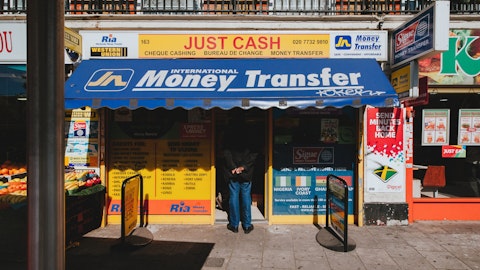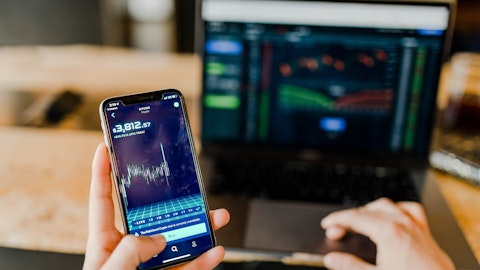David Scharf: Great, thanks. Good morning and thanks for taking my questions. Hey, I wanted to follow-up on Mike’s question regarding sales force and specifically agent growth. I know in years past, you’ve kind of shied away from providing an agent count number. You’ve spoken more broadly about the opportunity in various regions. But it is kind of one of the most tangible ways for investors to kind of visualize those seeds that you’re planting as you noted Bob. Can you provide us with a framework for thinking about the growth in the footprint that’s embedded in your guidance or the growth in the productivity per agent that’s embedded in your guidance based on the comments about refocusing on agent productivity?
Bob Lisy: Yes. I think the first piece of it is that we need to drive same-store sales. We’ve got a base of agents and for instance, if you could drive same-store sales with the core of agents of in the middle teens, for instance. Now I’m not saying it’s there today, but it has been and in our highest growth times, then that’s going to drive and provide the base. You’re always going to get more growth from same-store than you are from new. You’ll get the growth from the new agents in their second year, which by definition is same-store. So our €“ what Randy was talking about is a focus not so much on new agent locations, certainly there is, but to bring up new agent locations and then not be as productive is not a great thing.
Our average retailer averages well over 400 transactions a month. So you could kind of calculate back from our transactions to get a number of how many retailers we have. That number is a number we’d like to drive to well over 500 per month. Now, the mix of that means you’re bringing in new retailers that are kind of early stage that may be only producing 50 or 100 wires at the beginning or even 200 wires, and that mix kind of brings you down a bit, but that really driving force will be the performance from existing and that rifle shot approach. We think though, let’s take for instance somewhere like California. We think that we could easily double our agent network there and we’re putting the resources there to be able to do that. We know we’re going to have on the ground there 10 or 12 people that are selling, which in the past we’ve had maybe as many as only six or seven or eight.
So we’re going to be increasing resources, driving more agents. But in the end of the day, as Randy said, we’re going to be also looking at productivity. So it’s not so much about the number we add in terms of the productivity of them. And we haven’t really been disclosing the number of new adds we have or the number of new adds that we’re targeting. But I can tell you that 80% of our growth will come from same-store and the remainder of the growth comes from new agents.
David Scharf: Got it, got it. Understood. And I know in years past you used to have some slides that actually broke out kind of the percentage of your agents that were one to three, maybe three to five years old and over five, given that they had different growth trajectories. Any more kind of granularity into that just visually, I think provides a healthy window into how much organic
Bob Lisy: Yes, I understand. And we’ll take a look at that. I think part of our challenge is, is that we’re compete against a lot of companies that are not public and have access to a lot of data, and we look at the other public companies and what they’re sharing and we sometimes may be overshared and then it made us a really great target for competitors. So we don’t want to overshare, we want to give the market as much as we possibly can and give our competitors as little as we possibly can, right? So that’s that fine line that we walk.
David Scharf: Absolutely. Understood. Hey, one follow-up regarding the buyback $100 million is a formidable figure. I’m just curious what is the analysis that goes into coming up with such that figure precisely versus $75 million or $125 million? Is it covenant restricted based on how much of net income you’re allowed to buyback based on your loan agreements? Is it based on internal formula as a multiple or percentage of free cash flow over certain periods of time? Just a little color on kind of how that $100 million figure derived?
Andras Bende: Yes, David, this is Andras. I’d say, we’ve proven that the buybacks been a good use of capital and I think the program that we’re buying under, we don’t plan, I guess, in the short-term to change much. But we did think having an allocation of, as you said, a formidable number like a $100 million gave us the opportunity that, hey, if we wanted to kind of re-look how we think at capital allocation, we have then the flexibility to go and increase the buyback if it makes sense. So I think the point is we wanted a number that allowed us to run with the current program for a while and also allowed for the latitude if we wanted to rethink capital allocation for the company.
David Scharf: Understood. Great. Thank you.
Operator: Our next question will come from Alex Markgraff with KeyBanc Capital Markets. You may now go ahead.
Alex Markgraff: Hey, everyone. Thanks for taking my question. I actually had a couple. First just on the principal send amount. I appreciate the kind of breakout between core Intermex and La Nacional. I guess just curious in the 2023 guide, maybe just a bit more detail as to what’s embedded in your assumptions around principal send amounts?





